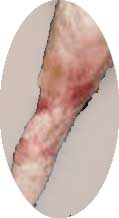While the Vast Majority of
Familial Shar-Pei Fever (FSF) episodes seen in Shar-Pei run a fairly
benign course there are occasional exceptions which can have
life threatening consequences. Streptococcal Toxic Shock Syndrome (STSS)
has been seen more frequently as a complication of FSF in the
Chinese Shar-Pei.
STSS involves infection with a group G streptococcus called
Streptococcus canis. Generally this streptococcal infection is a
rapidly progressing, highly invasive process which results in a
necrotizing faciitis and/or STSS leading to a shock-like syndrome
and multi-organ failure.
If not recognized early STSS can lead to death in 24 hours or less.
A similar syndrome has been seen in human medicine, the so-called
"flesh-eating bacteria".
Necrotizing Faciitis
This would be considered a localized form of streptococcal
infection. Dogs with
Necrotizing Faciitis
(NF) tend to develop extensive soft tissue sloughing along fascial
planes. Fascia is dense connective tissue which covers the
muscles. Usually this syndrome shows as large areas of skin and the
underlying fatty tissue dying and peeling away, hence it has been
called 'flesh eating bacteria'. Many of these dogs will survive
with debridement or clearing away of the dead tissue, but healing is
prolonged and skin grafts are often necessary.
Long-term management is intense, with frequent bandage
changes, cleaning of the wounds, antibiotic therapy and the need for
multiple anaesthetic procedures to repair and reconstruct the
damaged areas. The affected areas are usually the hock joints, the
flanks and the abdominal skin.
Streptococcal Toxic Shock Syndrome
STSS seems to be a generalized or systemic form of streptococcal
infection. Streptococcus canis in a potent exotoxin producer
and it is thought that in cases of STSS the toxin may be responsible
for the rapid progression of sepsis, shock and multi-organ failure (MODS).
On necropsy these dogs show severe edema of the gastrointestinal
tract, congestion of multiple organs, severe pulmonary (lung)
congestion and evidence of thromboembolism (blood clots) all
pointing to shock due to sepsis or toxemia. These dogs typically
die within 24-48 hours in spite of aggressive fluid therapy,
antibiotic treatment and intensive supportive care.
 |
Clinical signs in the
localized form of STSS, necrotizing fasciitis, consist of
areas of skin bruising, dead skin and/or areas of sloughing
where the skin is falling away. Usually there is a pus
discharge from these areas. The dogs are very painful,
running a high temperature, depressed and, in general, sick
dogs. Often there is a history of an FSF episode, dog fight
wounds, or other traumatic event. In the generalized or
systemic form of STSS symptoms have a much more rapid onset
and are more shock-like such as severe weakness, rapid heart
rate, pale mucous membranes, extreme pain, collapse, coma
and acute death. Many of these dogs develop DIC
(disseminated intravascular coagulation) which rapidly leads
to multiple organ dysfunction syndrome (MODS) and death
despite heroic efforts at treatment.
|
The cause of this condition is
unknown. It is known that Streptococcus canis can be part of
the normal bacterial flora of the dog and that NF and STSS have
occurred in other breeds.
Predisposing factors in the Shar-Pei may be related to:
The increased
amounts of mucin in the subcutaneous tissues.
The prevalence
of FSF in the breed.
The prevalence of dog fights and bite wounds in the breed.
An increase in skin laxity resulting in more trauma.
Immune system insufficiencies.
Perhaps an increased virulence of some strain of Streptococcus
canis.
Diagnosis is based on the
history of previous trauma or FSF episode, bacterial culture and
sensitivity of discharges or tissue samples, and clinical signs.
One important point is that the organism is often resistant to
enrofloxicin (Baytril®) and the aminoglycosides such as Amikacin®
and Gentocin®.
Consider the use of multiple antibiotic therapy with agents such as
Clavamox®, Cephalexin, Clindamycin, Lincomycin, Erythromycin,
Penicillin and the Potentiated Sulfas. Of course, the best approach
is based on sensitivity information from a culture, but that takes
some time to generate.
Treatment of the necrotizing fasciitis involves appropriate
antibiotic selection and administration, and basic wound care of the
affected areas. Most dogs have recurrence of necrotizing fasciitis
with repeat FSF episodes. Usually they seem to slough out the same
area every time. Treatment of the STSS involves intensive care with
intravenous fluid therapy, shock treatment with IV antibiotics, pain
management, possibly steroids, and intensive monitoring for the
development of DIC, etc. At this time the prognosis for systemic
STSS must be considered very poor.
Increased owner awareness of NF and STSS, rapid initiation of
appropriate antibiotic therapy and intensive supportive care are the
keys to survival in this condition. |



